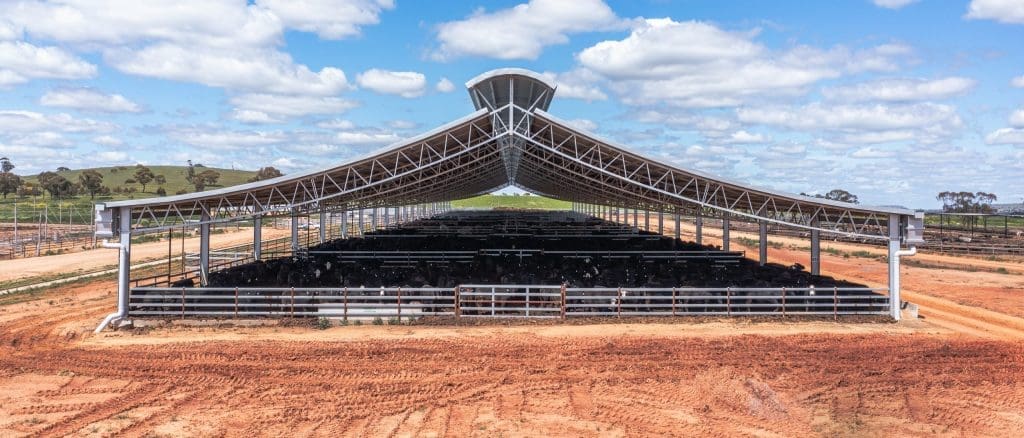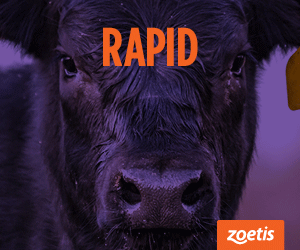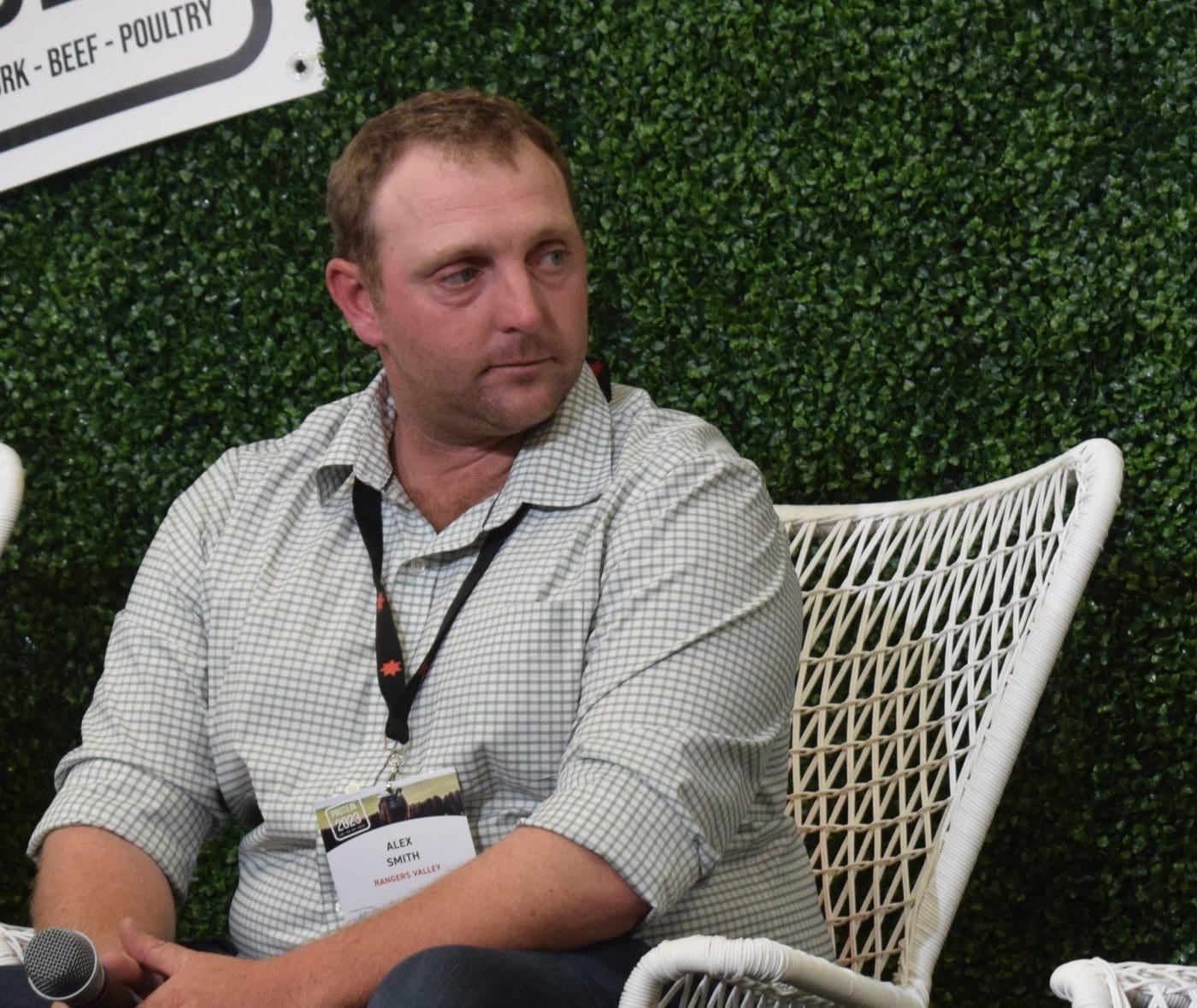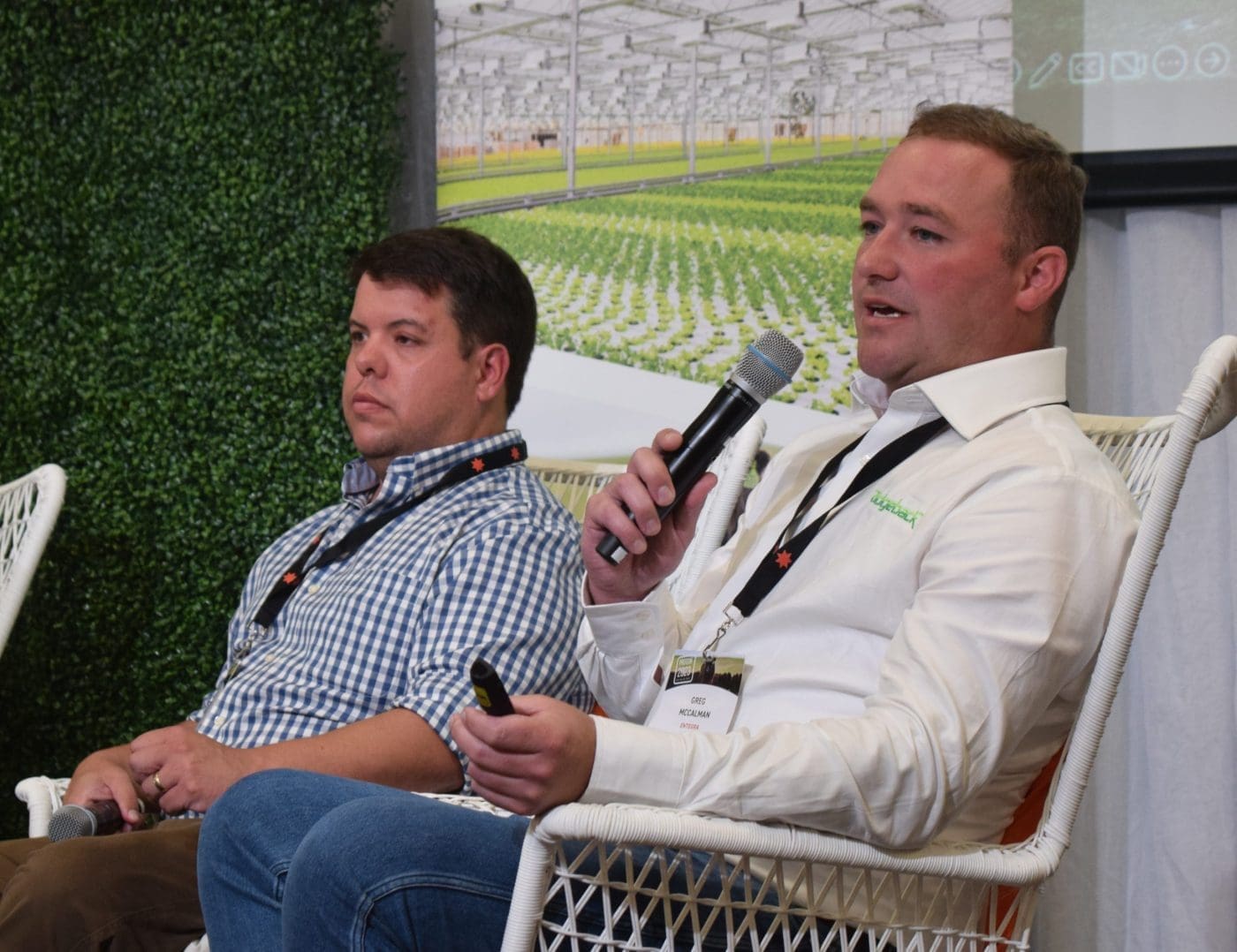
AS AUSTRALIA’S lotfeeding sector looks to become fully shaded by 2026, some operators are now looking to take the next step and put permanent shed structures over pens.
Most operations featured in Beef Central’s Top 25 Lotfeeders are now either fully shaded or have plans to become fully shaded in the next two years. Some have replaced first generation shade structures with new, better designs. Others have either put in shed structures or have expressed interest in sheds – mostly for high-end programs like Wagyu.
Another attraction to building sheds appears to be about putting feedlots in areas where it may not have been possible before. One lotfeeder on the top 25 list told Beef Central he could see more feedlots emerge in high-rainfall areas like North Queensland with effective shedding options and regulations to back them up.
There have been a small number of Australian feedlots employing shedding cover for decades, for different reasons. The pioneers included the Japanese-owned Tasmania feedlot and the Ashleigh Park feeding facility in southern NSW, originally built for Wagyu. Recent large feedlot shedding projects that Beef Central is aware of include Canning Downs near Warwick in southern QLD; Rangers Valley, Glen Innes NSW; Yarralinka Pastoral, SA; Stanbroke Beef Chinchilla QLD; and Teys Charlton, Victoria.
Plenty of work is also underway to quantify the impact of sheds on animal welfare and production, with a recent study by the University of New England and Meat & Livestock Australia finding significant benefits on both factors.
Large-scale Northern New South Wales lotfeeder Rangers Valley told the recent Toowoomba Surat Basin Enterprise protein conference in Dalby about its plans to build shed cover over eight existing pens. The company is almost finished its first shed which is 440m long and 30m wide.
Rangers Valley is not new to sheds and has had two areas covered for about 30-years. Feedlot manager Alex Smith said the company has taken some learnings from the old sheds in the design of its new ones.
“The idea of the new sheds is to give the animals the choice on whether to be inside or outside,” Mr Smith said.
“Our old sheds were quite low, which meant we did not get the amount of airflow we would like and they stay quite dark.”
Like most of the yards showing interest in sheds, Rangers Valley has a high percentage of longfed cattle – with a 270-day Angus program taking up the most capacity and a Wagyu program.
The yard is situated on the New England Tablelands, near Glen Innes, where temperatures can drop to -10 degrees and pen conditions can stay wet for months on end. Mr Smith said managing pen conditions was a big driver for the waterproof covers.
“We want that morning and evening sun to help dry and control the floor pack and we didn’t really bolt fans on, we just wanted a big shed with good light and airflow,” he said.
“Hopefully we can manage the floor pack without any bedding, but if we do, my preference will be to use woodchip. But once this shed is finished, we are going to run our own trials to answer some of the questions about bedding.”
The old sheds at Rangers Valley have a concrete floor and cover the entire pen, which Mr Smith said made them ideal for holding finished cattle before sending them to processors.
 “If we get wet over winter, we end up with a significant dag-load and we actually have a facility to wash the cattle down before they exit,” he said.
“If we get wet over winter, we end up with a significant dag-load and we actually have a facility to wash the cattle down before they exit,” he said.
“After we have washed the cattle, we send them to the shedded pens for the about two weeks before dispatch – so they are more of a holding pen than a feeding pen.”
Do the economics add up?
The panel at the conference was asked the difficult question about whether the economics of sheds add up and how long it would to pay off the large investments.
Asked about the economics of the investment, Mr Smith said the company was hoping for a five-year payback.
“We are hoping the sheds will give us better performance and better feed conversion like the studies have shown and we are also hoping to save some money with a reduction in the amount of woodchip we need for bedding,” he said.
“Once we have run these trials in the new shed over the next year, we will get a better idea of how they function and will know more about payback.”
The price of almost all materials required to build sheds has boomed in recent years – shed builders have also been in short supply. Greg McCalman from Entegra, which designed the feedlot-specific Ridgeback and is building the Rangers Valley sheds, said there could be a reprieve on the price or raw materials soon.
“We haven’t seen heavy steel coming down yet, but we have seen cold-rolled steel softening off and we have been given a 10pc reduction at the end of April,” he said.
“That is good news right across the board and we are likely to see a continuance of that unless someone does something silly.”
Mr McCalman was asked about how the company pitches payback to its customers, which he said varied on different areas and different situations.
“We have seen dairy and feedlots make a return on investment in 18 months – but I wouldn’t expect that on all sheds,” he said.
“There are a lot of different variables, outside the usual stocking density and feed conversion, that contribute to the long-term payback – like animal welfare, heat-load, reducing the cold and the possible carbon benefits.”
Stocking density legislation
The ultimate payback for investing in sheds would be an increase in stocking density, an aspect which is still facing regulatory issues in some states, including Queensland. The Queensland Government currently has recommended stocking densities for cattle feedlots – but does not specify for sheds.
Lillvale feedlot’s Laird Morgan said in an earlier Beef Central article, that clear regulations will be key to the operation’s shed building plans.
“Those who have already built shed cover do not really have any security yet over whether it is the right sized shed, for the number of cattle they aim to house,” Mr Morgan said.
“If we are going to invest in expensive shedding infrastructure, we want to be able to do it in the most efficient way possible, aligning pen sizes with the number of cattle we want.”
Engineering and town planning firm AgDSA has been looking into the feasibility of building sheds on feedlots. Director Matt Norton said in most jurisdictions an increase in stocking density will trigger a series of approvals.
“There is a lack of understanding about the impact of shedding on odour and on paper you are not going to get that odour benefit – which can impact stocking density and bedding management,” Mr Norton said.
“We are finding that a lot of governments are waiting for industry to generate that data and often industry is looking for guidance. There is an impasse on who is going to move first, and we are finding in most states that industry is having to give regulators guidance on how to do their job.”
Mr Norton said some governments may lean on sheds to approve feedlots where they have not been approved before.
“We had one example in South Australia, which is on sandy soil overlaying limestone and shallow groundwater where your conventional feedlot would not have been approved,” he said.
“But with a shed, you can consider concrete floors and you can get a feedlot approved on an area where you otherwise would not get a feedlot.”
Mr Norton said if sheds with a higher stocking density were to become more commonplace in the lotfeeding industry, there would be serious concerns about the available bedding.
“I think bedding availability is going to be one of the main drivers of shed investment in 10-years’ time,” he said.
“Looking in Southern Australia, bedding is more plentiful in the hay growing areas and areas close to pine plantations. My experience with Qld is that the poultry guys have a lot of the bedding supplies locked up in the south-east – the early adopters on the Darling Downs are going alright, but there might be concerns there further down the track.”


